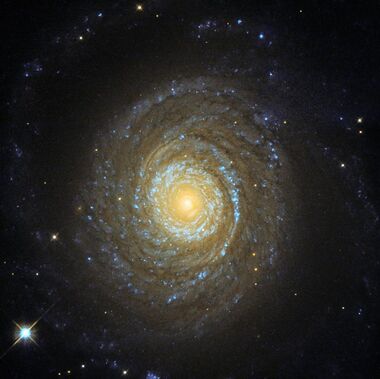Astronomy:NGC 6753
Coordinates: ![]() 19h 11m 23.635s, −57° 02′ 58.44″
19h 11m 23.635s, −57° 02′ 58.44″
| NGC 6753 | |
|---|---|
 | |
| Observation data (J2000 epoch) | |
| Constellation | Pavo |
| Right ascension | 19h 11m 23.635s[2] |
| Declination | −57° 02′ 58.44″[2] |
| Redshift | 0.010421±0.000087[3] |
| Helio radial velocity | 3,140 km/s[4] |
| Distance | 142 Mly (43.6 Mpc)[5] |
| Apparent magnitude (V) | 11.9[6] |
| Apparent magnitude (B) | 11.84[7] |
| Characteristics | |
| Type | (R)SA(r)b[8] |
| Mass | ~1013[5] M☉ |
| Apparent size (V) | 2′.4 x 2′.1[6] |
| Other designations | |
| NGC 6753, PGC 62870[7] | |
NGC 6753 is a massive[5] unbarred spiral galaxy,[5] seen almost exactly face-on, in the southern constellation of Pavo.[6] It was discovered by the English astronomer John Herschel on July 5, 1836.[9] The galaxy is located at a distance of 142 million light years from the Milky Way,[5] and is receding with a heliocentric radial velocity of 3,140 km/s.[4] It does not display any indications of a recent interaction with another galaxy or cluster.[5]
The morphological class of NGC 6753 is (R)SA(r)b,[8] indicating it is a spiral without an inner bar feature (SA), displaying outer (R) and inner (r) ring structures, and moderately wound spiral arms. It is being viewed nearly face-on with a galactic plane inclination by 30° to the line of sight from the Earth.[5] The galaxy is flocculent in appearance with a prominent central region.[8] The virial mass of the galaxy is ~1×1013 M☉, while the stellar mass is 3.2×1011 M☉. It has a star formation rate of 15.5 M☉·yr−1, which is confined to a radius of 15 kpc around the core.[5] The most active region of star formation is the inner ring.[10] It has a hot, X-ray luminous corona[6] that extends out to a radius of 50 kpc.[5]
Up to three supernovae have been discovered in this galaxy. The candidate type II-P supernova SN 2019mhm was discovered by the BOSS team on August 2, 2019. This transient was spotted close to maximum with a magnitude of 16.6, but showed no radio emission.[11][12] Supernova SN 2000cj was discovered by Robert Evans on May 14, 2000. It was positioned against a spiral arm at an offset 35″ east and 19″ south of the galaxy nucleus.[13] The spectrum showed this to be a type Ia supernova.[14] On May 13, 2005, type Ic supernovae SN 2005cb was spotted by the Brazilian Supernovae Search team.[15] It was offset 16″ west and 19″ north of the nucleus and reached a peak magnitude of 15.6.[16]
References
- ↑ "More than meets the eye". https://www.spacetelescope.org/images/potw1738a/.
- ↑ 2.0 2.1 Skrutskie, Michael F. et al. (1 February 2006). "The Two Micron All Sky Survey (2MASS)". The Astronomical Journal 131 (2): 1163–1183. doi:10.1086/498708. ISSN 0004-6256. Bibcode: 2006AJ....131.1163S.
- ↑ Corwin, H. G., Jr.; Emerson, D. (August 1982). "Optical spectra and redshifts for seventy-one galaxies.". Monthly Notices of the Royal Astronomical Society 200 (3): 621–644. doi:10.1093/mnras/200.3.621. Bibcode: 1982MNRAS.200..621C.
- ↑ 4.0 4.1 Tully, R. Brent et al. (2016). "Cosmicflows-3". The Astronomical Journal 152 (2): 21. doi:10.3847/0004-6256/152/2/50. 50. Bibcode: 2016AJ....152...50T.
- ↑ 5.0 5.1 5.2 5.3 5.4 5.5 5.6 5.7 5.8 Bogdán, Ákos et al. (November 2017). "Probing the Hot X-Ray Corona around the Massive Spiral Galaxy, NGC 6753, Using Deep XMM-Newton Observations". The Astrophysical Journal 850 (1): 11. doi:10.3847/1538-4357/aa9523. 98. Bibcode: 2017ApJ...850...98B.
- ↑ 6.0 6.1 6.2 6.3 Streicher, Magda (October 2010). "Pavo - A Fanciful Bird". Monthly Notes of the Astronomical Society of South Africa 69 (9 and 10): 183–189. Bibcode: 2010MNSSA..69..183S.
- ↑ 7.0 7.1 "NGC 6753". SIMBAD. Centre de données astronomiques de Strasbourg. http://simbad.u-strasbg.fr/simbad/sim-basic?Ident=NGC+6753.
- ↑ 8.0 8.1 8.2 Seidel, M. K. et al. (2015). "Dissecting galactic bulges in space and time – I. The importance of early formation scenarios versus secular evolution". Monthly Notices of the Royal Astronomical Society 446 (3): 2837–2860. doi:10.1093/mnras/stu2295. Bibcode: 2015MNRAS.446.2837S.
- ↑ "Hubble Snaps Photo of Unusual Spiral Galaxy NGC 6753". September 18, 2017. http://www.sci-news.com/astronomy/hubble-spiral-galaxy-ngc-6753-05232.html.
- ↑ Cacho, R.; Seidel, M. K.; Ruiz-Lara, T.; Sánchez-Blázquez, P.; Falcón-Barroso, J.; Pérez, I.; Vogt, F. P. A.; Ness, M. et al. (May 2015). "Kinematical decomposition of stellar populations in disc galaxies". in Cenarro, A. J.; Figueras, F.; Hernández-Monteagudo, C. et al.. Highlights of Spanish Astrophysics VIII, Proceedings of the XI Scientific Meeting of the Spanish Astronomical Society held on September 8-12, 2014, in Teruel, Spain. pp. 154–159. ISBN 978-84-606-8760-3. Bibcode: 2015hsa8.conf..154C.
- ↑ Kundu, Esha; Ryder, Stuart (August 2019). "Radio observations of SN 2019mhm". The Astronomer's Telegram 13040 (13040): 1. Bibcode: 2019ATel13040....1K.
- ↑ SN 2019mhm. https://www.wis-tns.org/object/2019mhm. Retrieved 2021-01-06.
- ↑ Evans, R. O. et al. (May 2000). Green, D. W. E.. ed. "Supernova 2000cj in NGC 6753". IAU Circular 7425 (1): 1. Bibcode: 2000IAUC.7425....1E.
- ↑ Suntzeff, N.; Kundu, A. (May 2000). Green, D. W. E.. ed. "Supernova 2000cj in NGC 6753". IAU Circular 7428 (2): 2. Bibcode: 2000IAUC.7428....2S.
- ↑ Turatto, M. et al. (May 2005). Green, D. W. E.. ed. "Supernovae 2005br, 2005bs, 2005cb". Central Bureau Electronic Telegrams 156 (1): 1. Bibcode: 2005CBET..156....1T.
- ↑ Barbon, R. et al. (2008). "Asiago Supernova Catalogue". CDS/ADC Collection of Electronic Catalogues. Bibcode: 2008yCat....1.2024B.
External links
- Rojas, Sebastián García. "Galaxy NGC 6753 - Spiral Galaxy in Pavo Constellation · Deep Sky Objects Browser" (in en). https://dso-browser.com/deep-sky/7919/ngc-6753/galaxy.
 |

